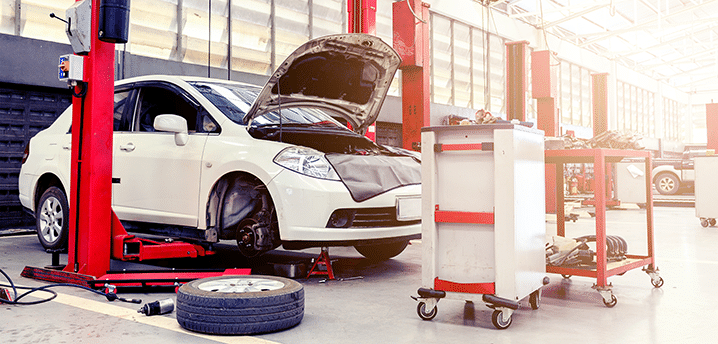Both scheduled and unexpected car maintenance can add up quickly. Here’s how to budget beforehand.
It can generally be said that if we want something to last a long time, we need to take care of it regularly. This is especially true when it comes to one of our bigger personal purchases: our cars.
Regular auto maintenance is an important part of owning and driving a vehicle, and can help ensure that our cars last as long as possible. Certain maintenance tasks can prevent bigger (more expensive) problems while others keep our cars reliable and efficient.
Of course, this maintenance comes at a cost. Depending on what kind of car you drive, your vehicle’s age, and how you drive it, these expenses can run in the hundreds or thousands of dollars a year. Here’s a look at what sort of maintenance costs you can expect when buying a new vehicle or used car and how to plan for those expenses so they don’t catch you off-guard.
How Much Does Car Maintenance Cost?
There are many factors that go into the auto maintenance costs you’ll incur in a given year. These include your car’s make and model, age, and current mileage, as well as how the vehicle is driven on a regular basis.
If you commute five highway miles to work each day, your car’s maintenance needs will be different than someone who sits in LA traffic for hours and hours. If you have a new car, you’ll probably encounter fewer large repairs than if your car is 14 years old.
With that said, a recent analysis published by AAA found that maintenance, tire, and repair costs average about 9 cents per mile. This means that someone who drives 15,000 miles per year can expect average maintenance expenses of about $1,341.


8 Common Auto Maintenance Expenses
It’s hard to predict when your vehicle’s transmission will go out or when the radiator will overheat, making it difficult to plan for those big repair expenses. What you can do, though, is easily plan ahead for the most common car needs.
Each vehicle will have its own maintenance needs and manufacturer recommendations. Spend some time with the owner’s manual for your vehicle to see which maintenance services are needed for your car and at which intervals.
Here’s a look at some of the most common expenses and how much they typically cost.
Oil change
- Frequency: every 5,000 to 7,000 miles
- Average cost: $35 to $75 for conventional, $65 to $125 for synthetic (also depends on engine size and location)
Once upon a time, the recommendation was to change your vehicle’s oil (and oil filter) every 3,000 miles or three months. Modern oil lubricants can have a much longer lifespan, though, averaging between 5,000 and 7,000 miles, according to AAA. If you opt for synthetic oil — which is a bit more expensive — you can get up to 15,000 miles out of a single oil change.
Considering that the average vehicle owner drove 14,263 miles in 2019, based on United States Department of Transportation Federal Highway Administration data, that means that you could potentially go an entire year on one oil change. It’s important to see what your vehicle manufacturer recommends, though, and also account for factors like climate, your car’s age, and how those miles are driven (stop-and-go traffic versus open highway, for example).
Tire rotation
- Frequency: every 6,000 to 8,000 miles
- Average cost: $20 to $120
Depending on your vehicle, how it’s driven, and even the quality of your alignment and tire balance, you can expect that each tire on your vehicle will wear just a little bit differently from the other three. For this reason, it’s important to regularly rotate your tires, to better ensure that they wear out at the same pace.
On average, manufacturers recommend rotating your tires every 6,000 to 8,000 miles or so. This is pretty close to the interval recommended for oil changes, so many drivers choose to do both maintenance tasks at the same time. This may also be more affordable, as shops and dealerships may offer discounted pricing when you bundle both services.
You can expect a tire rotation to cost somewhere between $20 and $120, depending on your location, vehicle type, and even tire size.
Air filter change
- Frequency: at least every 12,000 to 30,000 miles
- Average cost: $70 to $100 for cabin air, $54 to $68 for engine air
While your vehicle’s air filters are easily forgotten, they play an important role in keeping both you and your car healthy. Your engine air filter allows your vehicle to take in the clean air it needs to operate and not overheat. Your cabin air filter ensures that you always have clean air circulating in your car’s interior, filtering out dust, mold, pollen, and other contaminants.
In many cases, these filters are fairly easy to check and change on your own (especially the cabin air filter, which is typically located in or behind your glove box). You might be surprised at how simple this swap can be.
If you’d rather have someone else take care of this service for you, though, expect to pay around $70 to $100 for a cabin air filter replacement at the dealership. An engine air filter replacement averages between $54 and $68 at a shop.
You should plan to replace your engine air filter every 15,000 to 30,000 miles or so, depending on your manufacturer’s recommendation, while cabin air filters should be changed annually or an average of every 12,000 to 30,000 miles. If you have allergies, live in a dusty or high-pollen area, or have a lot of pollution in your city, consider changing this filter more often.
Multi-point inspection
- Frequency: 1-2 times a year or before long trips
- Average cost: Complimentary in many cases, or between $150 to $200
A vehicle inspection can be invaluable when it comes to checking multiple parts and systems on your vehicle for damage or wear. A multi-point inspection can do just that, giving you the all-clear on a regular basis or, for example, before you go on a long road trip.
Many dealerships and shops will offer multi-point inspections for free as part of another service (such as an oil change). If you’re only getting an inspection done, expect to pay somewhere between $150 to $200, depending on what it includes.
Wiper replacement
- Frequency: every six to 12 months or as needed
- Average cost: $61 to $85
Windshield wipers are one of those parts that you only think about when you need them. And when you do need your wipers — such as during a rainstorm or to clear off a dirty windshield — their functionality is pretty important.
Wiper blades need to be replaced as soon as you begin noticing a decline in their effectiveness. Many manufacturers recommend replacing them every six to 12 months, though some brands (and climates) will let you stretch this even longer.
Swapping wiper blades is another one of those regular maintenance tasks that is super simple to do on your own (and can save you some money). If you want your local shop to change them out, though, expect to pay somewhere around $61 to $85.
Brakes pads and rotors
- Frequency: every 40,000 miles or so
- Average cost: $250 to $400 per axle
Arguably, the most important thing your car can do for you — aside from getting you from point A to point B — is stop when you need it to stop. And for that, you’ll need brake pads and rotors in good working order.
You should consider replacing your brakes every 40,000 miles or so; if you drive hard or are constantly in stop-and-go traffic, expect to replace them even sooner. You should have your brakes inspected at least once or twice a year, and pay attention to any shaking, squealing, clicking, or grinding noises that may indicate wear or damage.
A brake job will cost an average of $250 to $400 per axle, depending on where you live and the type of car you drive. However, larger vehicles (such as SUVs or trucks) or high-performance brake systems can be a lot more expensive. For example, the average cost of a brake pad replacement on a Honda Civic is between $222 and $262 per axle, but for a Chevrolet Suburban, it ranges from $235 to $278.
Fluid flush
- Frequency: every 60,000 to 100,000 or so, depending on vehicle
- Average cost: $98 to $475, depending on fluid type and other factors
Certain fluid systems in your vehicle will need to be flushed at regular intervals to decrease build-up and prevent damage or added wear. Depending on your vehicle and model year, this could include a transmission flush, coolant line flush, and even a brake fluid flush.
These vary in cost by fluid flush type, vehicle, and location. On average, though, expect to pay between $98 and $123 for a coolant flush and between $412 and $475 for a transmission fluid service.
Battery replacement
- Frequency: every 3-4 years
- Average cost: $45 to $250
While you shouldn’t have to replace your car battery too often, it’s a hefty expense and can be inconvenient if it goes out on you unexpectedly. Many experts recommend having your battery load-tested once a year or so to check its performance.
You’ll typically need to replace it every three or four years, though drivers in hotter or more humid climates may need to replace their battery more often. Battery costs depend on the vehicle and size of the battery, but average between $45 and $250.
Tire replacement
- Frequency: Varies
- Average cost: $167 per tire
Perhaps one of the easiest places to visualize your vehicle’s wear is on the tires. These tires get you safely to your destination and can affect the quality of your ride as well as your gas mileage.
How often you need to replace your tires depends on the type of tires you have, how you drive, what sort of roads you’re on, the climate, and how often they are rotated/balanced/aligned. Even the Rubber Manufacturer’s Association says that there isn’t any good data regarding the serviceable life of an average tire. Your tire’s manufacturer may have recommended mileage limits to note, however.
Really, though, that means it’s up to you to regularly check the wear, tread, inflation, and appearance of your tires to see when they need replacing. If you get a nail or other damage in certain areas of your tire, you’ll need to replace it sooner than later.
The cost of tires can vary widely, from tens of dollars well into the thousands per tire. According to a recent Consumer Reports survey, though, members paid an average of $167 per tire.
Predicting (Bigger) Repairs and Services
The services above are the most common, predictable ones and are generally found on every car’s maintenance schedule. However, that’s not all that could happen to your vehicle. There are some services and much bigger repairs that you could encounter; if you’re outside of your vehicle’s warranty period, these could cost you hundreds or thousands of dollars out of pocket… and often, unexpectedly.
Pricey repairs could include things like:
- Belt replacement
- Transmission repair
- Caliper replacement
- Exhaust or muffler repair
- Air conditioner service
- Alternator replacement
- and more
As your vehicle gets out of warranty (if applicable), consider paying more attention to these systems to head off bigger issues. You may even want to create a seasonal maintenance checklist to help keep you accountable.
How to Budget for Car Repairs and Maintenance
According to recent data, many Americans would find themselves in a tough spot if their car suddenly broke down or needed a large repair. In fact, a Federal Reserve study found that 39% of adults wouldn’t be able to cover an unexpected $400 auto repair bill without using a credit card or borrowing money from friends or family.
It’s easy to see then that budgeting for car repairs and maintenance costs before they’re needed is a wise move. By setting aside some earmarked savings, you’ll ensure that new brakes, a blown tire, or an A/C motor won’t be detrimental to your family’s savings.
Here’s how you can factor these repairs and car maintenance into your own budget:
- Gather up your past receipts. Look at credit card statements, mechanic’s reports, and even ask your dealership for a list of the recent transactions on your account.
- Calculate the average spent annually. While your car will likely need bigger (and more expensive) repairs as it gains both years and mileage, previous years can give you a good baseline for savings. Calculate how much you spent over the last year on auto maintenance, or average your spending from the last two to three years.
- Find your monthly savings goal. Take that annual average and divide that number by 12. This is your monthly savings goal, or the amount you need to set aside each month in order to save up for your projected car maintenance costs.
- Save a little extra. As mentioned, your car will likely need more (or bigger) repairs as it ages. You may want to increase your savings year over year to ensure that you have a buffer for some of those bigger issues.
- Automate your savings. It can be easy to forget about car maintenance when your vehicle is running fine. If you forget to contribute to your auto repair savings, though, you may not have enough set aside for when you need it. Instead, consider automating your savings into a dedicated account each month, so you meet your goal without extra effort.
How Can I Reduce My Car Maintenance Expenses?
Want to avoid those unexpected repair bills and maintenance costs? Aside from regular inspection and saving ahead of time, here are some other ways to cut costs when you see that check engine light pop on.
Extend your warranty
If your vehicle is nearing the end of its warranty period, consider whether an extended warranty would be a wise move. These don’t typically cover every repair, but could save you thousands if you have a serious mechanical breakdown.
Take advantage of dealership offers
Many dealerships offer service plans, memberships, or at the very least, monthly coupon offers for service. Whichever you choose, try to never pay full price for scheduled maintenance if you can avoid it.
Buy into a vehicle service contract
A vehicle service contract is a third-party policy that can help you pay for unexpected repairs. These are typically purchased when you buy your car, but some are available if and when you refinance your auto loan, or anytime if your vehicle is under a certain year or mileage limit.
Vehicle service contracts (VSCs) are not car insurance or a warranty. Instead, these cover certain mechanical failures for a specified term. They don’t usually include routine maintenance and may only cover a portion of repair costs; even with a deductible and coverage limits, though, these can still pay for themselves if you encounter a big enough issue.
Planning for Auto Maintenance Can Make It More Manageable
If it has four wheels, it’s probably going to give you trouble at some point. Planning ahead for both routine and unexpected auto maintenance costs, however, can help you avoid a tough financial situation.
Knowing what to expect in terms of your vehicle’s annual maintenance, as well as setting aside some extra savings for those sudden repairs, will ensure that you don’t go into debt while trying to keep your car up and running.
About The Author
RateGenius
A better way to refinance your auto loan. RateGenius works with 150+ lenders nationwide to help you save money on your car payments. Since 1999, we've helped customers find the most competitive interest rate to refinance their loans on cars, trucks, and SUVs. www.rategenius.com
;)



